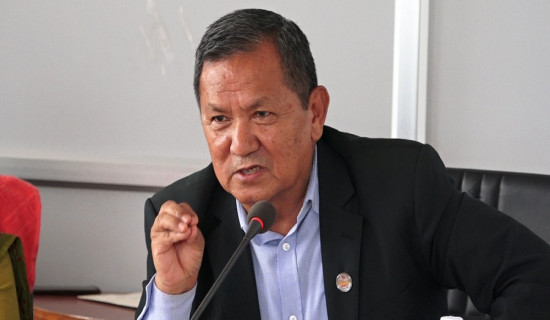- Saturday, 15 February 2025
National Paddy Day being marked today
By A Staff Reporter,Kathmandu, June 30: The 20th National Paddy Day is being marked across the nation on Friday.
The day is observed on the 15th day of the Nepali month of Asar every year to mark the arrival of the paddy cultivation season. Asar 15 is also celebrated as a day to enjoy curd and beaten rice.
Nepal started celebrating Asar 15 as National Paddy Day from 2005 as per a minister-level decision taken on December 14, 2004. This year’s slogan of National Paddy Day is "Climate resilient farmers' friendly technology for increasing rice production”.
The objective of this slogan is to promote the research and development of climate-adaptive techniques as well as technologies to reduce the increasing negative impact of climate change on rice cultivation and to make farmers aware of adopting these techniques, said Dr. Ram Krishna Shrestha, Chief of Centre for Crop Development and Agro Bio-diversity Conservation.
According to him, at the central level, paddy day will be marked on the premises of Nepal Agricultural Research Council by planting paddy with the help of machines in the presence of minister, farmers, researchers and government officials.
Similarly, various other programmes will be conducted in provincial and local levels to encourage farmers to use climate-resilient technology for increasing rice production, he said.
“As climate change has emerged as a formidable challenge to paddy plantation and its productivity, we have chosen the slogan to promote climate-friendly techniques to increase production,” he said. 11% plantation complete Paddy plantation has completed in around 11.13 per cent of the country’s total paddy field so far.
Shrestha said that paddy has been planted in 11.13 per cent (166,000 hectares) of the total paddy field (1.49 million hectares) across the country, down 6 per cent from 17 per cent last year.
The monsoon entry got delayed and is also weaker than an average at present, he told The Rising Nepal.
“It is projected that the average rainfall will be lower by 30 per cent this year than previous years, if this happens, the plantation are and production this year will fall,” he said. According to him, the plantation has not been started smoothly in Madhes Province due to a lack of adequate rainfall.
The highest paddy plantation has been done in Karnali and Sudurpaschim provinces so far.
Paddy has been planted in 22.6 per cent (10270 hectares) of the total paddy field in Karnali, 22.6 per cent (39,750 hectares) in Sudurpaschim Province, 16.96 per cent (57,814 hectares) in Koshi Province and 11.08 per cent (34,482 hectares) in Lumbini Province.
Likewise, 6.89 per cent (6742 hectares) paddy plantation has been completed in Gandaki and 4.99 per cent (6,034 hectares) in Bagmati Province and 2.84 per cent (11,530 hectares) in Madhes Province.
Rice worth Rs. 33.6 billion imported Despite the huge potential for paddy production, the country is spending billions of rupees for the import of paddy and rice to meet the national demand.
Shrestha said that the lack of proper irrigation facilities, fragmentation of arable land, lack of workforce and low use of improved and hybrid varieties of paddy seeds are the challenges to increase production and productivity.
Import of paddy and rice has been increasing every year.
According to the statistics of the Department of Customs, paddy and rice worth Rs. 33.63 billion have been imported during the first 11 months of the current fiscal year 2022/23. The rice import during the review period has reduced compared to last year. Paddy and rice worth Rs. 48.16 billion had been imported during the first 11 months of the last fiscal year.
Rice and paddy worth Rs. 33.65 billion were imported in the fiscal year 2019/20 and it increased to Rs. 50.78 billion in the fiscal year 2020/21 and Rs. 47.57 billion in the fiscal year 2021/22.





-square-thumb.jpg)

-square-thumb.jpg)








